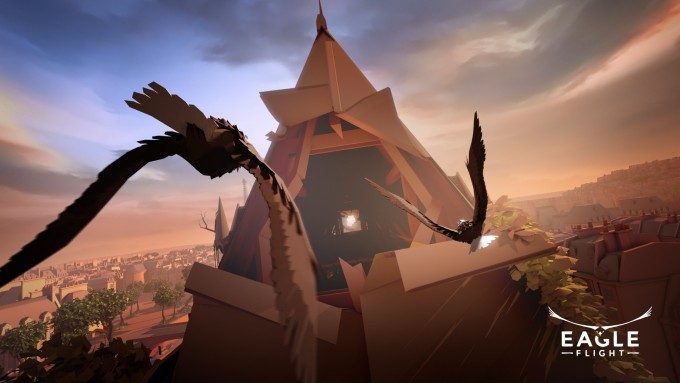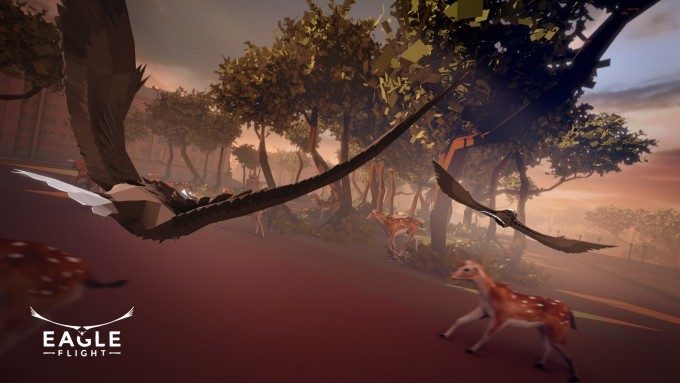Eagle Flight, the upcoming multiplayer game from Ubisoft Montreal, looks to be nearing finalization with the latest build we saw at the pre-GDC Oculus Gameday event. And while the game sounds like it ought to make you want to barf, we’ve finally got a good handle on some of the secret sauce behind the game’s comfort-based locomotion elements.
Flying at a fast clip around the historical sites in the 7th arrondissement in a human-free gay Paris sounds fun, ma oui? But swooping under bridges, weaving through the trees, alleyways and buildings can be a tricky thing if you don’t approach it right from a locomotion standpoint. Eagle Flight sounds like the sort of game that on paper would make you want to tear off a headset and drink a half-pint of Dramamine, but in practice it’s really one of the most comfortable high-speed games out there.
Making a 90 degree turn at 40 miles and hour would normally be something ill-advised in a first-person game, simply because the movement is too drastic, too great of a disconnect from your real world body (and brain) to process comfortably. But Ubisoft’s Montreal office has a few tricks up their sleeves, some of which we noticed for the first time when seeing the game mirrored directly on a monitor.
So here’s a quick breakdown of all the tweaks the team have made in pursuit of a kinetic, but ultimately comfortable experience:
- Proximity-based FOV Reducer – We only just recently clued into this addition to Eagle Flight. As you approach a wall or other obstacle, a slow opaque blackness creeps into your peripheral vision, obscuring the fast-moving scenery. When you’re in the headset itself, it’s hard to notice that it’s actually happening on first blush because you’re so focused on navigating the terrain directly in front of you. Oculus makes the offhand suggestion to reduce the breadth of displayed FOV to make an experience more comfortable in their Best Practice Guide, but up until now we haven’t seen this put into effect.
- The Beak – A rendered beak on the player (you are a bird after all) taps into the same reason a vehicle cockpit anchors you in a virtual space. Granted, a cockpit doesn’t make you bullet proof to VR-related nausea, but it certainly helps.
- Anchoring Particle Effects – Wisps of wind appear in front of you when you slow down or speedup in the game—two moments that sensitive users usually have the most difficulty with in first-person locomotion. Adding a temporary foreground element
- Gaze-based Flight – Look left, and you turn left at a constant rate until you look forward again. Roll your head left and you bank left in the world at a constant rate until you straighten your neck again. Leaving the gamepad out of the equation lets you make sharper turns, something that Eagle Flight heavily depends on.
Bringing it all Together
I played an early version of Eagle Flight back at Gamescom in August, and the game has improved in polish significantly since then. The map is far from the once barren, untextured Assassin’s Creed asset that it once was and now shows off a much more customized, and decidedly cohesive low poly vibe that looks much less ripped from Ubisoft’s asset vault. Although there still aren’t any humans around, the city is now brimming with animals like giraffes and deer—because humans left the Earth for some unknown reason 50 years prior.
In a 3v3 match I didn’t capture and return a single flag (represented by a dead rabbit). And it’s really only because I’m not good at Eagle Flight in the least apparently. But the time I had at this GDC left a deep impression on me that I hope carries over to the final release. I want to learn more about the world of Paris without Parisians (or tourists), and visit every little nook of the city, or maybe just fly around and block out the fact that I have to pay my taxes soon. Ubisoft is also promising a single-player mode with “diverse missions and collectibles to uncover.”
The final game is slated to arrive in spring 2016, targeting PSVR, HTC Vive and Oculus Rift.








